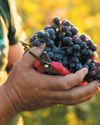
The wines of Cyprus are undergoing an extraordinary transformation. The enthusiasm and commitment amongst the younger generation of wine growers is palpable. But first some background.
I first visited Cyprus back in 1977 and took a photograph which turned out to be one of the very first things I ever had published. It was a road sign, with the caption, "Danger! Road slippery with grape juice." And indeed, a couple of days later, we followed a truck full of grapes heading for the local cooperative with a steady stream of grape juice oozing from it.
When I took the Master of Wine exams a couple of years later, we had a question in the fortified wine-tasting paper that comprised three Sherries. One was the real thing from Jerez; one was a potentially confusing example from South Africa and the third was an undistinguished example of the popular Cyprus Sherry brand, Emva. At that time, Cyprus was the third biggest importer of wine to Britain, after France and Italy.
Winemaking in Cyprus has had a chequered history. It is an island on a crossroads in the Eastern Mediterranean, so everyone has been there. Greeks, Romans, Byzantines, Normans, Venetians and Genoese. And then the Ottomans invaded the island in 1571 and wine production stopped for 300 years. Grape growing continued for table grapes and raisins, but winemaking did not resume again until the British colonised the island in 1878.
The island of Cyprus is dominated by the Troodos mountains, with their fascinating geology. The mountains were formed when two tectonic plates, the African and the Eurasian, crashed 92 million years ago. And then the Troodos, which had been eight kilometres under the sea, were suddenly thrown 1000 metres up in the air; quite simply, low became high. This is where geologists come to study an ancient seabed but curiously there are no seashells.
Denne historien er fra Autumn 2024-utgaven av Sommelier India.
Start din 7-dagers gratis prøveperiode på Magzter GOLD for å få tilgang til tusenvis av utvalgte premiumhistorier og 9000+ magasiner og aviser.
Allerede abonnent ? Logg på
Denne historien er fra Autumn 2024-utgaven av Sommelier India.
Start din 7-dagers gratis prøveperiode på Magzter GOLD for å få tilgang til tusenvis av utvalgte premiumhistorier og 9000+ magasiner og aviser.
Allerede abonnent? Logg på

Godinho Historic family owned restaurant
Feasting on Portuguese and Indigenous Goan flavours, relive the calm and quiet of a time long gone by,

Laurent Ponsot is one of Burgundy's most celebrated winemakers
Jon Wyand finally captured the mercurial Laurent Ponsot - a renowned winemaker and vintner known for his exceptional Burgundy wines - on camera

Exploring Brunello vintages
Ten years in the bottle, a long decant, and yet the harsh tannins overshadowed everything.

An ode to the diva grape
It is worth tasting Pinot Noir in all its varied roles - from the shy, delicate ingénue, and simple yet intense New World newbie to the full-on Grand Cru prima donna

Best ways to explore wine in a new city
The first thing most of us want to do when we go to a new city, be it Dallas or Boston, is to enjoy a few good wine tastings

Champagne Billecart-Salmon
One would think that a 200-yearold Champagne as renowned as Billecart-Salmon did not need any marketing, yet Billecart-Salmon AsiaPacific head, Sebastien Papin was recently in India to tell us about the brand and how the wine is best appreciated.

A thoughtfully curated wine experience
Wine tastings at Vintage Wines in Karjat, Maharashtra, are designed to enhance the appreciation of wine and deepen our understanding of it, writes

The legacy of Henri Gouges
The wines of Maison Henri Gouges from the commune of Nuits-Saint-Georges are considered among Burgundy's hidden gems

An overview of Sussex and
Rosemary George describes the importance of Sussex as an appellation and its potential for tourism

Shades of Rosé
Rioja and Navarra share a love for Grenache, producing two very distinct styles of rosé, writes Elizabeth Gabay MW, which succsesfully enrich the category as her tasting notes illustrate